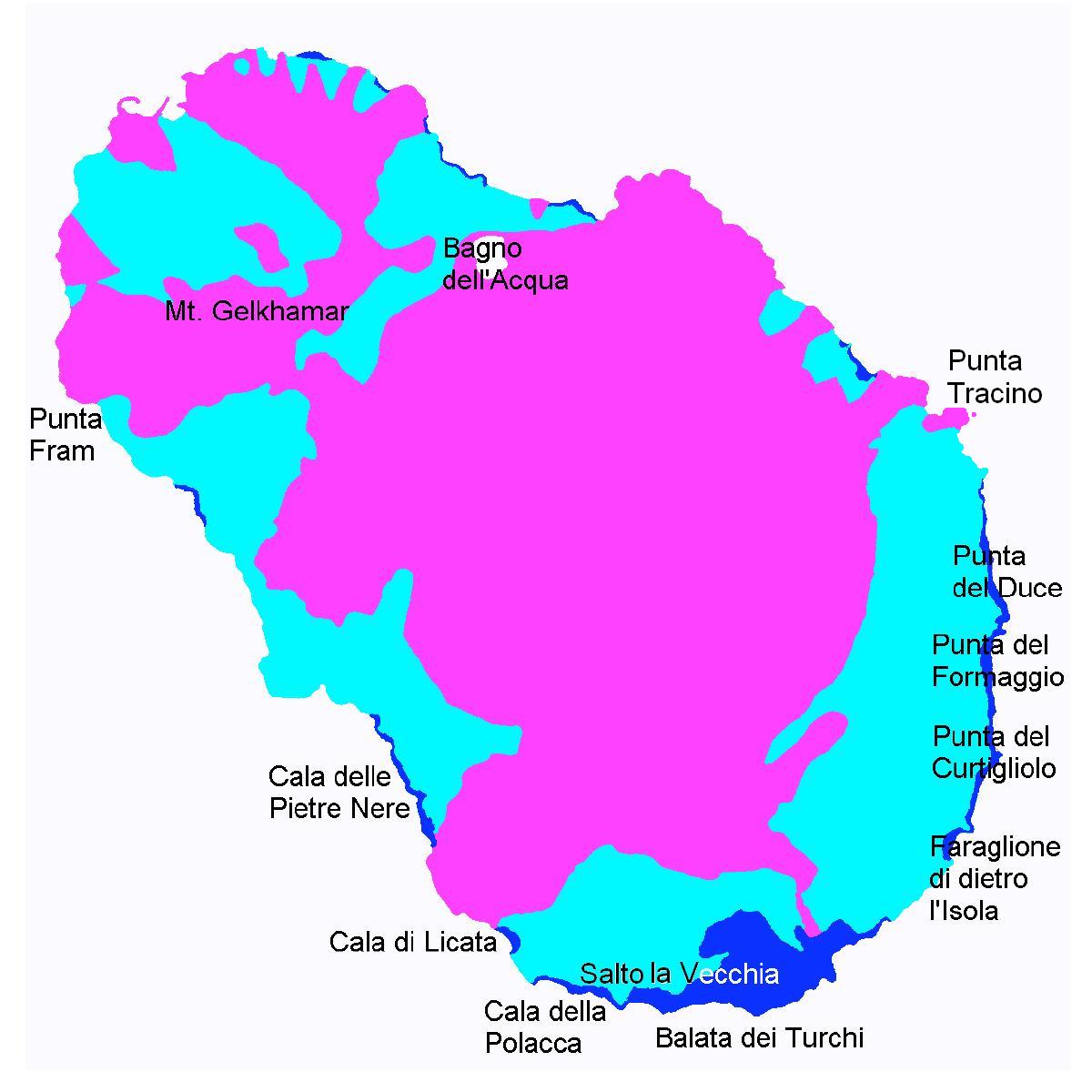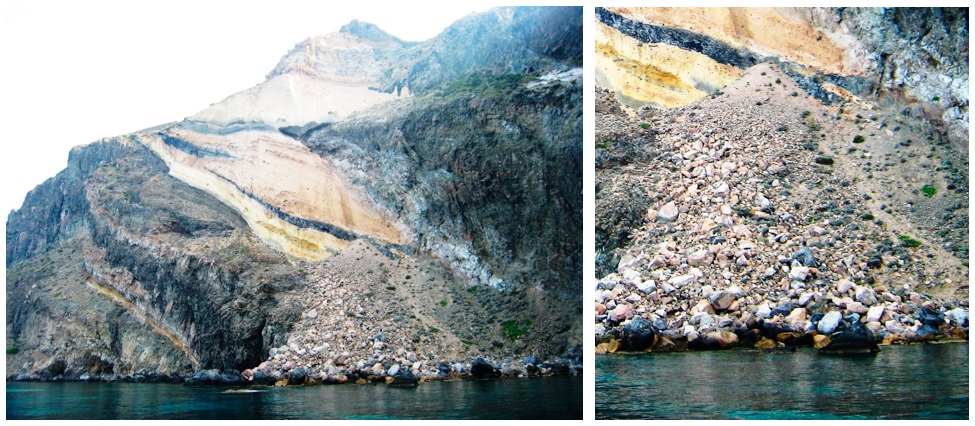To check whether the Strait of Sicily was really inhabited at the end of the Younger Dryas, obsidian could prove straightforward: given its uniqueness, finding some on a submerged seabed would demonstrate the seabed’s occupation at the time of its emersion.
Obsidian is a volcanic glass formed by the sudden cooling of lava rich in silicon. The possibility to chip it and create sharp edges, its hardness and its shine made it a material suitable for crafting tools, weapons and jewellery, turning it in one of the most wanted assets of the prehistoric age. Its macroscopic characteristics (colour, homogeneity, hardness) and its chemical composition (Cann and Renfrew 1964) are typical of each specific lava flow, making it possible to establish the geographical origin of obsidian artefacts found in sites far from their source.
Few volcanoes produce obsidian, because the conditions for its formation are rather uncommon. Since 1970 it has been known that only four islands (Sardinia, Palmarola, Lipari and Pantelleria) provided all the obsidian found in the western Mediterranean (Ammerman, Matessi, and Cavalli-Sforza 1978).
Although the first use of obsidian dates back to one hundred thousand years ago in the Horn of Africa (Walter et al. 2000), in the Mediterranean basin its utilization is normally associated with Neolithic culture. In the Western Mediterranean, the accepted chronology states that its systematic exploitation began about eight thousand years ago (Tykot 1996). In Sicily the use of obsidian is associated with the spread of Neolithic and agriculture in the region (Tykot 2002), a thesis also corroborated by recent excavations (Chilardi et al. 2012; Nicoletti and Tusa 2012), which confirmed the absence of obsidian in Palaeo/Mesolithic layers. The Neolithic association is also assumed valid on the other side of the Strait: the date of 8000 BP for the first use of obsidian is, for example, confirmed in Tunisia, by preliminary research undertaken by Mulazzani et al. (2010).
This general depiction seems not to leave much hope of finding pre-Neolithic specimens in the region. However, looking more closely, some odd details emerge. Naturally, the distance from the two Sicilian sources determined their geographic penetration. The island was basically divided into two market basins: the north-eastern one served by Lipari and the south-western by Pantelleria, but the supply changed with time. In some sites situated along the hypothetical border dividing the basins, both islands provided the obsidian : in the village of Mandria di Serra del Palco (Caltanissetta), which was continuously inhabited during prehistory, the percentage of Pantellerian material fell progressively during the Neolithic period in comparison to that from Lipari (Nicoletti 1997). A similar replacement of supply source happened in Cava dell’Uzzo (Trapani) (Leighton 1999) and at Skorba (Malta) (Trump and Cilia 2002, p. 67).
The timeline of the diffusion and the change in supply appear somewhat peculiar. Although the mineral had been always available in Pantelleria but not in Lipari (Lipari’s oldest flow dates back to eight or nine thousand years ago (Oddone and Bigazzi 2003)), it seems that nobody collected it before the Lipari eruption advertised the precious material. It is therefore to be understood why many ran initially to Pantelleria to collect it, although the version from Lipari, glassier and shinier, was always the favourite. As a matter of fact, later Lipari progressively became the only source for most sites.
A linear explanation could be that the exploitation actually started before the Neolithic era. This idea was initially suggested about twenty years ago by the discovery of some artefacts in Mesolithic layers (unfortunately in the presence of disturbed stratigraphy) and of a Liparian blade, found at Perriere Sottano (Catania) and dated 9500 BP cal. (Aranguren and Revedin 1998). It gained some strength when two other obsidian blades, dated between 9500 and 9800 BP cal., were later discovered at Favignana (Trapani) (Martini et al. 2012). But it was the recent discovery of a pre-Neolithic processing site near Punta Tracino (Pantelleria) at an underwater depth of about twenty metres (Abelli et al. 2014) which showed that the hypothesis is not entirely far-fetched.
The hope of finding obsidian processing residues on a submerged seabed is helped by another peculiarity of Pantelleria. The island shows no traces of human settlements at the time of its Neolithic exploitation and the remains of its lithic industry are far more modest than those of Lipari (Leighton 1999, p. 73), which instead became inhabited and acquired importance essentially due to its obsidian industries. Quite paradoxically, the first known traces of stable communities in Pantelleria date back to five thousand years ago, when collection of obsidian from the island was already very scant.
The absence of settlements contemporary to the obsidian exploitation period is usually explained by the intense agricultural terracing experienced by Pantelleria over the centuries, which would have erased the traces of the ancient sites (although it is yet to be understood why the terracing process did not erase more recent remains). However, the particularity of the island, barely cultivable and lacking beaches or a safe port, could itself justify the absence of stable settlements and the choice of a collection method that did not require operations on site. If so, the first recorded inhabitants may have only settled when the obsidian gatherers ceased to raid the island. If this is the context, the pre-Neolithic processing site on the seafloor of Punta Tracino could indicate a former occupation of its shores (now submerged) followed by an early Neolithic abandonment of the island, perhaps due to the vanishing of the archipelago that facilitated navigation to the mainland.

To illustrate a possible way of gathering obsidian without landing on the island it is helpful to summarize its orographic characteristics. Pantelleria’s geological history is marked by the Green Tuff eruption that almost completely covered it about forty-five thousand years ago (Civetta et al., 1984). Five obsidian flows have been identified: three almost horizontal layers at Balata dei Turchi and two deposits at Bagno dell’Acqua and Gelkhamar (Francaviglia 1988). The Gelkhamar source looks similar to the lava flows of the island of Lipari, NE of Sicily; the deposit at Bagno dell’Acqua is fragmented and scarce; but the conformation of the three lava flows at Balata dei Turchi is rather peculiar, although consistent with the orography of the southern part of the island (Rapisarda 2007). Because of the limited slopes and the absence of pronounced valleys, the southern part of the island is characterized by lava flows that extend almost uniformly around the volcanic cone. The obsidian flows most exploited for the manufacture of prehistoric objects were the southern ones, from Salto la Vecchia to Balata dei Turchi (Fig. 11). This prevalence, well known among the Sicilians finds (Tykot 1996), has been preliminarily confirmed in Tunisia too (Mulazzani et al. 2010).
The landslide at Cala delle Pietre Nere (Scauri), which dragged obsidian blocks from the above vein into the sea, suggests a practical method of collecting the mineral from the southern flows: skirting the shore with a boat and picking up what you need (Fig. 12). This does not require docking on the island - dangerous almost everywhere - or climbing the cliffs (even more hazardous). The method favours the collection of the raw material as it is, leaving the refining process for later, on the way back or once returned home. Such a collection method could easily explain the deficiency of industries for processing the mineral on the island.

If the obsidian was not treated locally due to the difficulties docking on the island, it might have been processed on a handy site along the route home. If exploitation was already active during the Younger Dryas, the islets that then emerged along the route to Sicily (Pantelleria Vecchia bank, for example) could have been a convenient place to do this job (Fig. 10). The remnants of an obsidian industry, if found there, would constitute irrefutable proof of human presence at the end of the Younger Dryas. Given that, as mentioned, a rather similar discovery has recently been made on the seafloor of Pantelleria (Abelli et al. 2014), the same kind of research at some selected spots on the Avventura bank at -20 and -40 should not be unthinkable.
Since 2018 this site has been accessed times;
Atlantis has been visited times.